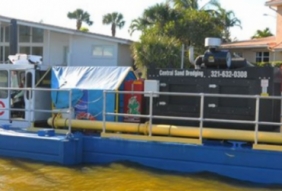
Posted on February 1, 2016
Central Sands is using an Ellicott Swinging Ladder dredge to deliver a milestone this week in the cure for Indian River Lagoon, sucking up decades of mayonnaise-like muck from a Cocoa Beach canal.
On Thursday, the Ellicott dredge began removing the built-up muck from a canal along the Banana River Lagoon.
The $2 million project includes closing the Jack/Kent canal from 8 a.m. to 5 p.m. Monday through Friday over the next four to six weeks, according to Brevard County Natural Resources Management Department.
The project then will progress south, dredging five other canals.
Central Sand Inc., based in Brevard County, will dredge 83,000 cubic yards of muck from the six canals, placing the spoil on 10 acres of city owned land just north of Brightwaters Drive.
From there, after the muck settles out, it will be trucked to a permanent site near Space Coast Regional Airport in Titusville.
The project is a joint venture with the city of Cocoa Beach.
Muck — rotted plant matter, clays and soils from construction sites — has been likened to “black mayonnaise.” It blocks sunlight to seagrass and contributes to bacterial decay, which consumes oxygen in the water, causing fish kills.
“Each canal will take about three weeks (to dredge),” said Matt Culver, boating and waterways program coordinator.
Citizens who live just south of Brightwaters Drive should expect some truck traffic and dust, officials said.
“We’re trying our best to minimize the impact on them,” said Wayne Carragino, the city’s project manager.
“It’s going to be returned to the original condition once it’s done,” he said of the spoil site.
The project is one of five dredging projects that will remove a combined 1.4 million cubic yards o f muck from the lagoon, enough muck to fill an Olympic-sized swimming pool about 437 times.
Lagoon advocates hope that will help begin to cure a lagoon ailing from years of algae blooms. A “superbloom” of green algae in 2011 and subsequent brown algae blooms killed off 60 percent of the lagoon’s seagrass, the barometer of the estuary’s ecological health. Hundreds of manatees, dolphins and pelicans also died in the wake of the blooms.
In 2014 and 2015 the Florida Legislature allocated a combined $20 million toward dredging five sites: the mouth of Turkey Creek in Palm Bay; canals along Sykes Creek and in Cocoa Beach; the Grand Canal and associated canals in Satellite Beach; and waters near Jones Road boat ramp in Mims.
The funding includes $2.5 million to the Florida Institute of Technology to study the before and after of the dredging project in Turkey Creek to measure the environmental benefits.
The Turkey Creek project is expected to begin in mid February. Officials hope to complete the project by May, when environmental rules prevent dredging because of manatees in the creek.
Central Sand Inc., based in Brevard County, will dredge 83,000 cubic yards of muck from the six canals, placing the spoil on 10 acres of city owned land just north of Brightwaters Drive.
From there, after the muck settles out, it will be trucked to a permanent site near Space Coast Regional Airport in Titusville.
The project is a joint venture with the city of Cocoa Beach.
Muck — rotted plant matter, clays and soils from construction sites — has been likened to “black mayonnaise.” It blocks sunlight to seagrass and contributes to bacterial decay, which consumes oxygen in the water, causing fish kills.
“Each canal will take about three weeks (to dredge),” said Matt Culver, boating and waterways program coordinator.
Citizens who live just south of Brightwaters Drive should expect some truck traffic and dust, officials said.
“We’re trying our best to minimize the impact on them,” said Wayne Carragino, the city’s project manager.
“It’s going to be returned to the original condition once it’s done,” he said of the spoil site.
The project is one of five dredging projects that will remove a combined 1.4 million cubic yards o f muck from the lagoon, enough muck to fill an Olympic-sized swimming pool about 437 times.
Lagoon advocates hope that will help begin to cure a lagoon ailing from years of algae blooms. A “superbloom” of green algae in 2011 and subsequent brown algae blooms killed off 60 percent of the lagoon’s seagrass, the barometer of the estuary’s ecological health. Hundreds of manatees, dolphins and pelicans also died in the wake of the blooms.
In 2014 and 2015 the Florida Legislature allocated a combined $20 million toward dredging five sites: the mouth of Turkey Creek in Palm Bay; canals along Sykes Creek and in Cocoa Beach; the Grand Canal and associated canals in Satellite Beach; and waters near Jones Road boat ramp in Mims.
The funding includes $2.5 million to the Florida Institute of Technology to study the before and after of the dredging project in Turkey Creek to measure the environmental benefits.
The Turkey Creek project is expected to begin in mid February. Officials hope to complete the project by May, when environmental rules prevent dredging because of manatees in the creek.





